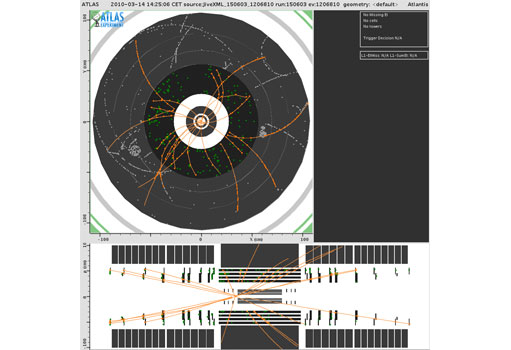
ATLAS e-News
23 February 2011
Surprise collisions
29 March 2010

Armin Nairz noted the 45 centimetre displacement of the z-vertex in his presentation last Tuesday
Unlike last November – when the Control Room was rammed with people holding their breaths for hours on end, awaiting the moment when the LHC would finally collide protons in ATLAS for the first time – the first collisions of 2010 were a complete surprise. At least as far as those on shift were concerned.
“The first thing that caught my eye was one of the event displays … it looked like it had activity,” recalls Shift Leader Jim Degenhardt (who, incidentally, was also Shift Leader for those first ever ATLAS collisions).
It was 14:26 on Sunday March 14th when the machine teams turned off the separation bumps – magnets that keep the beams away from each other at the Interaction Point – so that they could observe the beam orbits. This was a final check in a string of parameter studies that the LHC team had been carrying out on the 1.18 TeV beams.
“We had no idea that they were going to do it,” says Jim. “Actually, if I’d been paying attention to the LHC Page 1 the entire time, I’d have seen the message. But they didn’t put up the message until they actually did it – basically the same time as I saw the activity. It was almost immediate.”
Jim called Run Manager Jonas Strandberg into the Control Room, before heading to the Trigger desk to check the MinBias rate. “We were pretty sure we were getting collisions at that point, so I called Tier-0 to let them know that we were running with the wrong project tag.”
Although the collisions themselves were intended purely as an LHC study, ATLAS benefitted from finding out how quickly people could react to an unexpected situation.
“Most of the reaction had to be done on the data preparation side. They had to first create a new configuration that could reconstruct the data correctly. Then they had to make sure that it got distributed to all the Tiers as if it was real collisions… because it was real collisions.”
Around 3200 2.36 TeV collisions were collected over a 40-minute period, with zero data lost. Within 24 hours, there were collision-monitoring histograms at Tier-0, and data had made it out to the Tier-1 centres less than one day after that.
In terms of the data itself, it can be used to compare luminosity measurements against other detectors’ studies, to test ATLAS’s luminosity-monitoring abilities and to check that the beam is high quality and not degrading as it circles.
On the 14th, the beams were out of sync by one ‘bucket’ (the staggered locations of each proton bunch in the beam structure), meaning that the collisions were displaced 44.3 centimetres towards the C-side endcap, peaking at -2.5 nanoseconds.
“The beams were off by one bucket longitudinally, and in addition may not have been colliding head-on,” explains Luminosity, Beam Conditions & Forward Detectors Run Coordinator, Witold Kosanecki. “Compared to what we saw last year, the instantaneous luminosity was about half and also the beam spot was a lot bigger. Both point to the fact that the optics and/or the beam trajectories had not been optimised.”
Responding to this, cogging studies carried out two weeks ago ensured that the beams matched up correctly for that weekend’s 450 GeV collisions. In the early hours of Friday March 19th, the LHC set new records when it accelerated both beams to 3.5 TeV for the first time. The machine has been performing surprisingly well so far, only being ‘unavailable’ 17 per cent of the time during week 10 (available 66 per cent of the time and on planned technical stops 17 per cent).
 Ceri PerkinsATLAS e-News
|